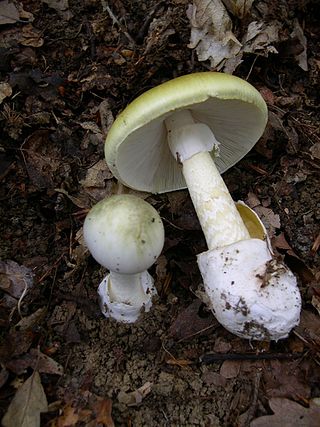
Mushroom poisoning is poisoning resulting from the ingestion of mushrooms that contain toxic substances. Symptoms can vary from slight gastrointestinal discomfort to death in about 10 days. Mushroom toxins are secondary metabolites produced by the fungus.
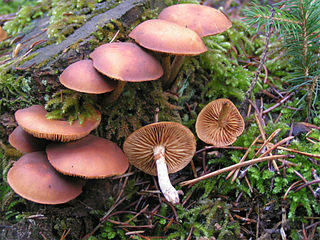
Galerina is a genus of small brown-spore saprobic fungi, with over 300 species found throughout the world from the far north to remote Macquarie Island in the Southern Ocean. The genus is most noted for some extremely poisonous species which are occasionally confused with hallucinogenic species of Psilocybe. Species are typically small and hygrophanous, with a slender and brittle stem. They are often found growing on wood, and when on the ground have a preference for mossy habitats.

The adjective hygrophanous refers to the color change of mushroom tissue as it loses or absorbs water, which causes the pileipellis to become more transparent when wet and opaque when dry.

Conocybe is a genus of mushrooms with Conocybe tenera as the type species and at least 243 other species. There are at least 50 different species in North America.
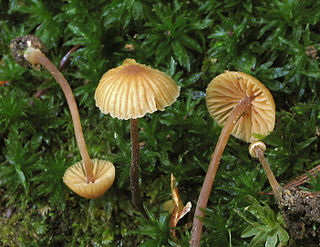
Galerina vittiformis is a species of agaric fungus in the family Hymenogastraceae, and the type species of the genus Galerina. It is widely distributed in temperate regions, where it typically grows in moist locations, often among mosses. The fungus has been shown to bioaccumulate various heavy metal from contaminated soil.
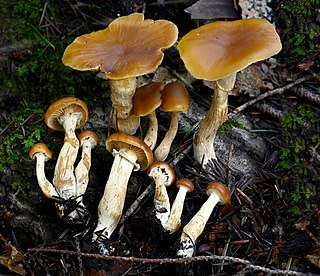
Galerina marginata, known colloquially as funeral bell, deadly skullcap, autumn skullcap or deadly galerina, is a species of extremely poisonous mushroom-forming fungus in the family Hymenogastraceae of the order Agaricales. It contains the same deadly amatoxins found in the death cap. Ingestion in toxic amounts causes severe liver damage with vomiting, diarrhea, hypothermia, and eventual death if not treated rapidly. About ten poisonings have been attributed to the species now grouped as G. marginata over the last century.
Alec E. Wood was a mycologist affiliated with the University of New South Wales in Sydney, Australia who published major studies, describing a large number of new species, in the genera Galerina and Amanita. With Tom May, he co-authored Fungi of Australia Volume 2A, Catalogue and Bibliography of Australian Macrofungi - Basidiomycota in 1997.
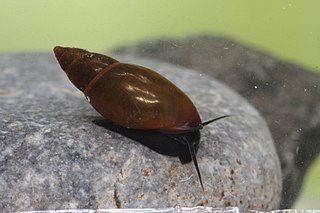
Aplexa hypnorum, or by the common name, the moss bladder snail, is a species of small air-breathing freshwater snail, an aquatic pulmonate gastropod mollusk in the family Physidae, a family which are sometimes known as the bladder snails.

The tree bumblebee or new garden bumblebee is a species of bumblebee common in the European continent and parts of Asia. Since the start of the twenty-first century, it has spread to Great Britain. These bumblebees prefer habitats that others do not, allowing them to pollinate flowers in areas that many other species do not get to.

The Hymenogastraceae is a family of fungi in the order Agaricales with both agaric and false-truffle shaped fruitbodies. Formerly, prior to molecular analyses, the family was restricted to the false-truffle genera. The mushroom genus Psilocybe in the Hymenogastraceae is now restricted to the hallucinogenic species while nonhallucinogenic former species are largely in the genus Deconica classified in the Strophariaceae.

Amaninamide is a cyclic peptide. It is one of the amatoxins, all of which are found in several members of the mushroom genera Amanita, Lepiota and Galerina. It differs from alpha-amanitin in lacking the hydroxyl group on tryptophan. This alters its UV absorption spectrum but not its toxicity.

Galerina sulciceps is a dangerously toxic species of fungus in the family Strophariaceae, of the order Agaricales. It is distributed in tropical Indonesia and India, but has reportedly been found fruiting in European greenhouses on occasion. More toxic than the deathcap, G. sulciceps has been shown to contain the toxins alpha- (α-), beta- (β-) and gamma- (γ-) amanitin; a series of poisonings in Indonesia in the 1930s resulted in 14 deaths from the consumption of this species. It has a typical "little brown mushroom" appearance, with few obvious external characteristics to help distinguish it from many other similar nondescript brown species. The fruit bodies of the fungus are tawny to ochre, deepening to reddish-brown at the base of the stem. The gills are well-separated, and there is no ring present on the stem.

Galerina patagonica is a species of agaric fungus in the family Hymenogastraceae. First described by mycologist Rolf Singer in 1953, it has a Gondwanan distribution, and is found in Australia, New Zealand, and Patagonia, where it grows on rotting wood.

Ligidium hypnorum is a species of woodlouse found across Europe and western Asia. It is a fast-moving, active species whichthat rarely grows longer than 9 mm (0.35 in). It is dark and shiny, and is similar in appearance to the common species Philoscia muscorum, and also the rarer Oritoniscus flavus. In Great Britain, it was first discovered at Copthorne Common, Surrey, in 1873, and most later records are also from South East England. It is considered a good indicator species for ancient woodland.
Phaeogalera is a small genus of slender, fleshy bog and swamp-inhabiting mushrooms with large, brownish spores with a germ pore and a hymenium lacking chrysocystidia. Phaeogalera resemble Galerina in their habitat, macroscopic appearance, and spore print color, however, their microscopic characteristics more closely resemble Psilocybe. The type species, Phaeogalera stagnina, has an Arctic-alpine distribution in the Northern Hemisphere extending into the boreal forests and taiga. It grows along the edges of bogs in peaty soils and sometimes amongst Sphagnum or other mosses. This type species has been classified in Galerina, Tubaria and Psilocybe. Modern molecular evidence supports the recognition of Phaeogalera as an independent genus separate from Galerina. The generic name is built upon the antiquated generic name "Galera", now synonymous with Galerina, and with a reference to the darker colors of the basidiospores of Phaeogalera. When originally proposed by Kühner, he forgot to fully cite the original publication for the type species which explains by the name was later validly published by Pegler & Young in 1975. The genus Meottomyces was segregated from Phaeogalera after briefly being classified together by Romagnesi.
Galerina steglichii is a mushroom species described by Besl in 1993 and named after Wolfgang Steglich.

Galerina graminea, known as the turf bell is a species of mushroom in the genus Galerina. Unlike many Galerina mushrooms, it can survive in moss-free grass. It was known for many years as 'Galerina laevis', proposed by Christiaan Hendrik Persoon. Galerina means helmet-like, while graminea means "of grass". It isn't known whether it is poisonous or not, however it is suspected to be.
Bryobilimbia is a genus of lichen-forming fungi belonging to the family Lecideaceae. It was circumscribed in 2014 by Alan Fryday, Christian Printzen, and Stefan Ekman. The type species is Bryolimbia hypnorum.














